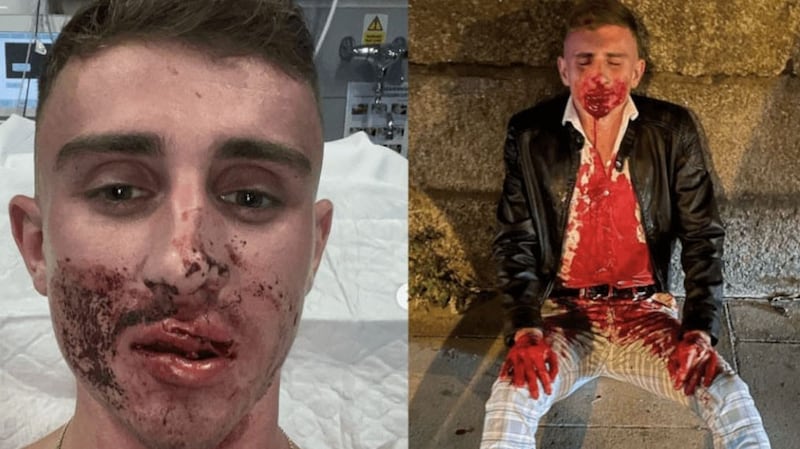There’s a burst of frantic activity from inside the noisy group before a man staggers away, bloody nosed and looking dazed having just been punched in the face. It’s about 7pm on Wednesday and a serious fight between two men has just ended on the boardwalk at Bachelor’s Walk in Dublin’s north inner city.
The fighters are a mismatched duo. One is a dishevelled street drinker aged about 40. Though he has just taken a serious beating, he is miraculously still clutching a can of beer.
His opponent, about 18 years old, stands at well over 6ft in height. His muscular build is clear to see as he has removed his top for the fight. A group of about 15 teenagers all mill around him, clearly delighted with the spectacle they’ve witnessed and the violence meted out by one of their number.

In the south inner city, assaults causing harm and public order incidents in the first quarter of this year dropped to their lowest level since the CSO began
Having happened across the fight by chance, The Irish Times jumps the wall, from boardwalk on the pavement, to avoid the volatile group but follows them when they move off. Some of them run up on to the Ha'penny Bridge and over into Temple Bar. They swear and shout as they go, getting involved in another altercation on Fownes Street Lower.
They dominate the environment because of their menacing antics and sheer numbers as they move loudly and at speed through narrow streets while drinking cans of beer. Lingering Covid-19 restrictions also mean there are far fewer people than normal around Temple Bar. And so the presence of a marauding teenage gang – missed by a matter of seconds by gardaí on foot and in a van – seems especially imposing and intimidating.
Is this a glimpse at the new Dublin, where anti-social behaviour and street violence has become more commonplace during the pandemic? Or is this the messy last gasp of lockdown that has already begun to right itself as Dublin reopens?
Woolley assault
The assault on Irish Olympian Jack Woolley near Grattan Bridge last Friday night shone a spotlight on the city for all the wrong reasons. The 22-year-old from Tallaght, Dublin, was out socialising when a man, one of group, randomly punched him full force in the face. The attacker's ring caught Woolley on the mouth, slicing his lip to the extent his shirt and trousers were left covered in blood.
There was predictable uproar after the images of the battered-looking Woolley emerged. Cllr Mannix Flynn described the boardwalk as a "completely no-go" area. Cllr Christy Burke said the city centre had been "abandoned" by the Garda.
Sinn Féin's justice spokesman, Martin Kenny TD, criticised the "low presence of frontline gardaí" which was a "direct result of years of underinvestment by successive Fianna Fáil and Fine Gael governments".

He criticised "out of touch . . . Labour Party Dublin Lord Mayor" Alison Gilliland for saying reported crime was down.
But she has a point.
In the Dublin South Central Garda division, which covers the south inner city, assaults causing harm and public order incidents in the first quarter of this year dropped to their lowest level since the CSO began publishing crime data 19 years ago. So-called “common assaults” – which are less serious than “assaults causing harm” – dropped to their lowest level since 2005.
In the Dublin Northern Central Garda division, which covers the north inner city, public order crimes and common assaults dropped in the first quarter of this year to their lowest level since 2016. During the pandemic, assaults causing harm in the city’s northern division have been at their lowest level since 2018.
Pearse Street Garda station in Dublin, which polices Temple Bar and the vast majority of Dublin’s social scene, said assaults in its area dropped by 44 per cent last year, more than three times the 13 per cent national average. No crime data is available for the period after the end of March this year.
Garda members who police the streets of central Dublin say they accept there are outbursts of anti-social behaviour, including assaults, in the city. But they insist the problem has not worsened during the pandemic.
“For a long time during the lockdown we had street drinking – we called it ‘takeaway pints’ and most of it was completely peaceful,” says one garda. “But then we’d a particular element coming in to town to hijack that situation. I think some of those people got comfortable running riot, if you like. And then we saw what happened on South William Street (where there were significant street disturbances in June). But things are getting back to normal.”
Another Garda member said it was inaccurate to suggest public disorder and assaults had increased in Dublin city during the pandemic.
“Anti-social behaviour is more noticeable now in town because it’s still not as busy as it used to be. But you couldn’t close pubs and nightclubs like we did and then claim crime was rising. The city was absolutely deserted and it’s still much quieter than normal.”
‘No-go area’
While he agreed the boardwalk was considered a “no-go area” by many people, he said those problems pre-dated the pandemic and would endure after it passed.
Dublin City Council chief executive Owen Keegan also said last week the sight of homeless people sleeping in tents in the streets “adds to that perception of an edginess about the city”.
In comments criticised by homeless charities, he said “well intentioned groups” continued to deliver services on the streets, though an abundance of supervised accommodation was available to rough sleepers.
He also blamed young people congregating and drinking causing “low level anti-social behaviour” for the perception the city centre was unsafe; something several business interests who spoke to The Irish Times agreed with.
Some people are coming into the city centre with intent to cause trouble and many of them believe they'll get away with it, especially if they are under 18
At Grogan's Pub on William Street South, manager Daniel Smith said he and his colleagues were enjoying a very positive reopening. Indeed, he believed the addition of outdoor seating by pubs and restaurants had brought a welcome "European feel" to the city.
“We were a bit apprehensive just before we reopened; wondering what way it was going to go. But all of our regulars have come back. The outdoor dining has given the place a warm atmosphere,” he said.
Mr Smith said some of the street drinking that was common in the area during periods of lockdown had lingered. But he did not feel it was menacing, unlike the disturbances seen on the street back in June.
“When we first reopened, we were still kind of getting that crowd on the street but the guards, as tough as it was for them, they policed it well,” he said. “They took a stern approach; not heavy-handed, but a no-tolerance policy to on-street drinking. And it’s worked, it’s got the street back to what it always was: nice bars and nice restaurants.”
Another source who works in the night-time economy has had a less positive experience, saying low-level antisocial behaviour was endemic and “very off-putting and frightening for people who come into town”.
He believed Garda resources were only significantly targeted at high-profile or very violent crimes.
Chief executive of the Vintners’ Federation of Ireland, Padraig Cribben, said he believed the pub trade and wider night-time economy was “pretty much coming back to normal”.
“In general teams, is it any worse than prior to Covid? Probably not, is the reality,” he said. Violence in the night-time economy was still “a rarity”.
Change for the better
At the Restaurants' Association of Ireland, chief executive Adrian Cummins, said as the Republic emerged from the pandemic, it could be an opportunity for Dublin to take stock and change for the better. He said the constant theme around safety and public order in the streets of the city was the need for frontline gardaí, though numbers in the force were at a record high.
“We need to know; what’s the number of guards required to police a European capital city the size of Dublin. We really need to get that point. We need the right number of gardaí on the streets, high visibility.”
He believed during lockdown “some people got used to drinking on the streets”, with “a bit of a free for all” emerging. While that was now being gradually overcome as businesses reopened, some of the antisocial behaviour predated the pandemic.
“Some people are coming into the city centre with intent to cause trouble and many of them believe they’ll get away with it, especially if they are under 18. That’s not good for a big capital city and we need to tackle that. I don’t think there’s as much of it going on as a few months ago, when you’d hear people saying the city centre was a no-go area. But that doesn’t mean anti-social is gone away, it’s still there.”












